Class 10 Economics Chapter 4 Notes - Globalisation and the Indian Economy
As consumers today, many of us have a diverse range of goods and services available. The latest models of digital cameras, mobile phones, and televisions from leading global manufacturers are easily accessible. Indian roads now feature a variety of car models each season, a departure from the past when Ambassador and Fiat were the dominant choices. This choice of brands extends to various products, from shirts to televisions to processed fruit juices.
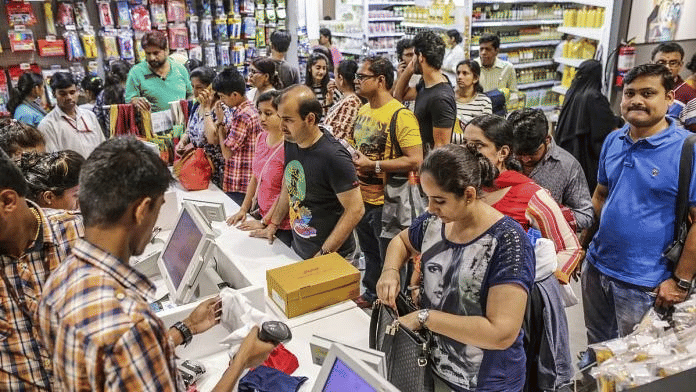 Consumer Choices
Consumer Choices
This abundance of choices is a relatively recent development in our markets, transforming rapidly within a matter of years.
The chapter explores the factors behind these changes and their impact on people's lives.
Production Across Countries
- Trade has historically been the primary means of communication between distant nations, and Multinational Corporations (MNCs) now play a crucial role in this process.
- An MNC, which oversees production in multiple countries, strategically establishes production headquarters and factories in regions with affordable labor and resources. This strategy aims to minimize production costs, enabling MNCs to maximize profits.
- MNCs choose locations close to markets where skilled and unskilled labor is available at economical rates, ensuring the availability of essential production elements.
- Additionally, MNCs may advocate for government measures that safeguard their interests in the regions where they operate.
 Factors on which location Selection Depends
Factors on which location Selection Depends
Interlinking Production Across Countries
Investment involves spending money on assets like land, buildings, machinery, and equipment. In the context of Multinational Corporations (MNCs), this investment is termed foreign investment, with the expectation of earning profits from these assets.
MNCs engage in global production through various methods of interaction with local producers:
Joint Production: MNCs often work together with local companies for joint production. This helps local businesses in two main ways:
- They receive financial investments to boost production.
- They gain access to advanced technology from the MNCs, which helps them produce more efficiently.
MNC Expansion and Influence through Acquisitions: Multinational companies (MNCs) often expand by buying local companies, using their vast wealth to do so.
For example, the American MNC Cargill Foods acquired the Indian company Parakh Foods, which had a strong reputation and marketing network in India. Cargill took over Parakh’s four oil refineries and became the largest producer of edible oil in India, producing 5 million pouches daily. Many MNCs have more wealth than the budgets of developing countries, giving them significant power and influence.Controlled Production: Large MNCs in developed nations place orders with small producers. Examples include garments, footwear, and sports items from various countries. These small producers supply goods, which MNCs sell under their own brand names. The MNCs control pricing, quality, delivery, and labour conditions for these producers, exerting significant influence over the production process.
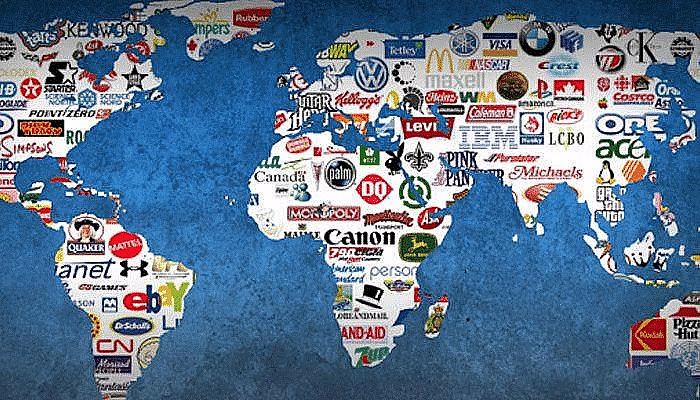 Interlinking Production Across Countries
Interlinking Production Across Countries
The partnership between MNCs and local businesses in production helps local firms in several ways:
- MNCs can provide funds for additional investments, such as acquiring new machinery to improve production efficiency.
- Multinational corporations introduce advanced manufacturing technology, assisting local businesses in modernisation.
Generally, MNCs establish production where they can easily access markets; where skilled and unskilled labour is available at low costs; and where other production factors are assured. Additionally, MNCs seek government policies that protect their interests.
Foreign Trade and Integration of Markets
- Foreign trade has historically linked nations through trade routes, allowing for significant exchanges. Trading interests led companies like the East India Company to operate in India.
- This trade enables producers to widen their market reach beyond local borders, allowing them to sell not only in their home market but also in international ones.
- Generally, as trade increases, goods move between markets. This leads to a greater selection of products available. Prices for similar goods across different markets start to align, resulting in strong competition among producers from various countries, regardless of distance.
- Thus, foreign trade connects markets or integrates them across nations, enhancing global competition and increasing choices for consumers.
- The example of Chinese toys in Indian markets illustrates the effects of foreign trade. Chinese manufacturers recognised an opportunity to export toys to India, where prices were high. With lower prices and fresh designs, Chinese toys gained popularity, leading to 70-80% of Indian toy shops opting to sell them within a year. Indian consumers benefitted from a wider selection of toys at reduced prices. However, Indian toy makers faced challenges, as their sales dropped significantly due to this competition.
What is Globalisation?
Globalisation means countries are becoming more connected through trade and investment from multinational companies (MNCs). It describes how quickly countries are integrating with one another.
The process of rapid Integration or interconnection between countries is called Globalisation
Let us see Examples
Microsoft :
- Microsoft has its main office in the USA.
- This company creates part of its software in India and other nations.
- Microsoft’s software is used globally.
Ford Motors:
- Ford Motors is located in the USA.
- The car factory in India not only makes cars for the Indian market but also sends cars to other developing countries.
- Additionally, the company may source gearboxes from one country, seat belts from another, and lights and mirrors from yet another country.
- Most parts are supplied by different vendors to Ford Motors, which puts them together to build the car.
All these activities help in generating employment opportunities across the world. This in turn affects the world economy.
You can think of various activities in the step of final production of a product or a service that take place around the world at different locations. This results in the interdependence of national economies around the world.
Factors that have Enabled Globalisation
Globalisation, the process of increasing interconnectedness and integration of economies, societies, and cultures on a global scale, has been facilitated by several key factors. These factors have played a significant role in enabling globalisation and shaping its trajectory. Here are some of the most important factors:
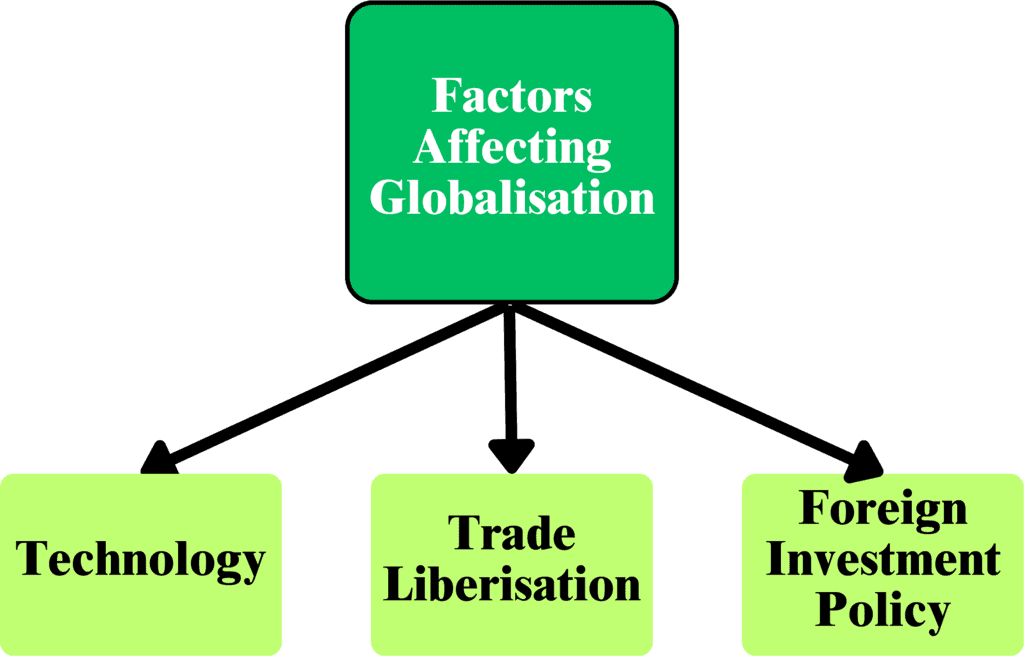 Factors Affecting Globalisation
Factors Affecting Globalisation
1. Technology:
- Transportation Technology: In the last fifty years, advances in transportation have made it quicker and less expensive to send goods over long distances, boosting international trade. The use of shipping containers has been crucial, as they can be easily transferred onto ships, trains, planes, and trucks. This has greatly lowered handling costs at ports and sped up the delivery of exports.
- Information and Communication Technology: Major developments in telecommunications, computers, and the Internet have changed how we communicate globally. Tools like telegraphs, telephones (including mobile phones), and fax machines allow people around the world to connect and access information instantly. These technological advancements have also propelled globalisation forward.
- Satellite Communication: Satellite technology has improved global connections, allowing for effective communication even from remote locations.
- Computers and the Internet: Computers are now essential in nearly every industry, and the Internet provides immediate access to information and communication. This includes sending emails, making voice calls, and sharing data at low costs. Additionally, the cost of air transport has decreased, allowing for much larger volumes of goods to be shipped by air.
2. Trade Liberalisation:
- Impact of Import Tax: If the Indian government imposes a tax on imported Chinese toys, their prices will rise, making them less appealing compared to local toys. This would lower imports and help Indian toy manufacturers.
- Trade Barriers: Taxes on imports represent trade barriers, which governments use to control foreign trade and manage the types and amounts of goods entering the country. For example, a tax on Chinese toys would make them more expensive, leading to fewer imports and supporting Indian toy-makers.
- Historical Context: After gaining independence, India used trade barriers to shield its developing industries from foreign competition, permitting imports only for necessary goods like machinery and fertilisers.
- Policy Changes in 1991: Beginning in 1991, India started to dismantle trade barriers and restrictions to foster competition, improve the performance of local producers, and attract foreign investment.
- Liberalisation: The process of removing trade barriers is called liberalisation. It allows businesses to make import and export decisions with fewer government restrictions, leading to a more open and competitive market.
3. Foreign Investment Policy:
Significant investments made by a company in a foreign enterprise are termed foreign direct investments (FDI).
- Purpose: This policy seeks to attract foreign investment to enhance economic growth, generate jobs, and introduce new technology and expertise.
- Regulation: Governments create guidelines to control how much and in which sectors foreign investors can invest. These rules protect local businesses and ensure that investments serve national interests.
- Liberalisation: Many countries have gradually relaxed restrictions to facilitate foreign investment. This liberalisation process aims to increase foreign investment by reducing bureaucratic barriers and offering incentives.
- Impact: Foreign investment can drive economic growth by creating jobs, advancing technology, and boosting competition. However, it is vital to balance foreign investment with the protection of domestic industries and national interests.
Role of MNC in Globalisation
In the globalisation process, Multinational Corporations (MNCs) play a vital role by:
- Expanding Markets: MNCs significantly contribute to globalisation. They facilitate the flow of goods, services, investments, and technology across borders, helping to broaden markets through extensive trade.
- Transfer of Technology: Globalisation is a fast-paced integration of countries. MNCs bring cutting-edge technology and effective management practices to new regions, enhancing the interconnectedness of production and markets worldwide.
- Investment and Growth: Increased foreign investment and trade result in tighter production and market integration. MNCs invest in local firms and infrastructure, which stimulates economic growth and job creation in host nations.
- Global Competition: MNCs foster global competition, which can improve product quality and lower prices for consumers.
- Cultural Exchange: MNCs promote cultural exchange by bringing new products and practices to different countries.
World Trade Organisation (WTO)
This organisation aims to liberalise international trade. This organisation says that all countries in the world should liberalise their policies.
- This organisation established the rules regarding international trade and sees that these rules are obeyed.
Currently, 161 countries are members of the WTO. India joined WTO on 1 January 1995.
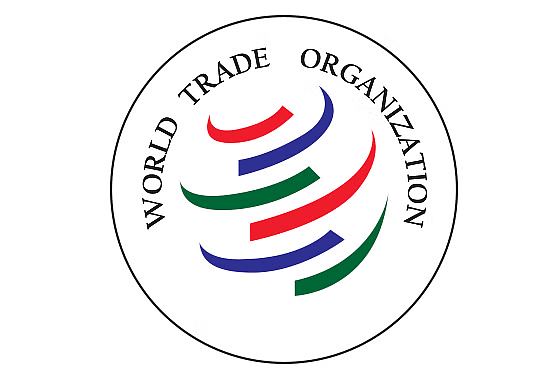 WTO Symbol
WTO Symbol
Support for Liberalization: International organizations, including the World Trade Organisation (WTO), support the removal of barriers to foreign trade and investment, advocating for free trade between countries.
WTO’s Role: The WTO, initiated by developed countries, aims to establish and enforce international trade rules. It currently has about 161member countries.
Imbalance in Trade Barriers: Developing countries question why they must lower trade barriers while developed nations continue to subsidise their farmers. They argue this situation raises the question of whether trade is genuinely free and fair.
Example of Discrepancy: An example of this imbalance is the ongoing debate over trade in agricultural products, highlighting the unequal impact of WTO rules on different countries.
Impact of Globalisation in India
Globalisation has had a significant impact on India across various sectors, transforming its economy, society, and culture. Here are some of the key impacts of globalization in India:
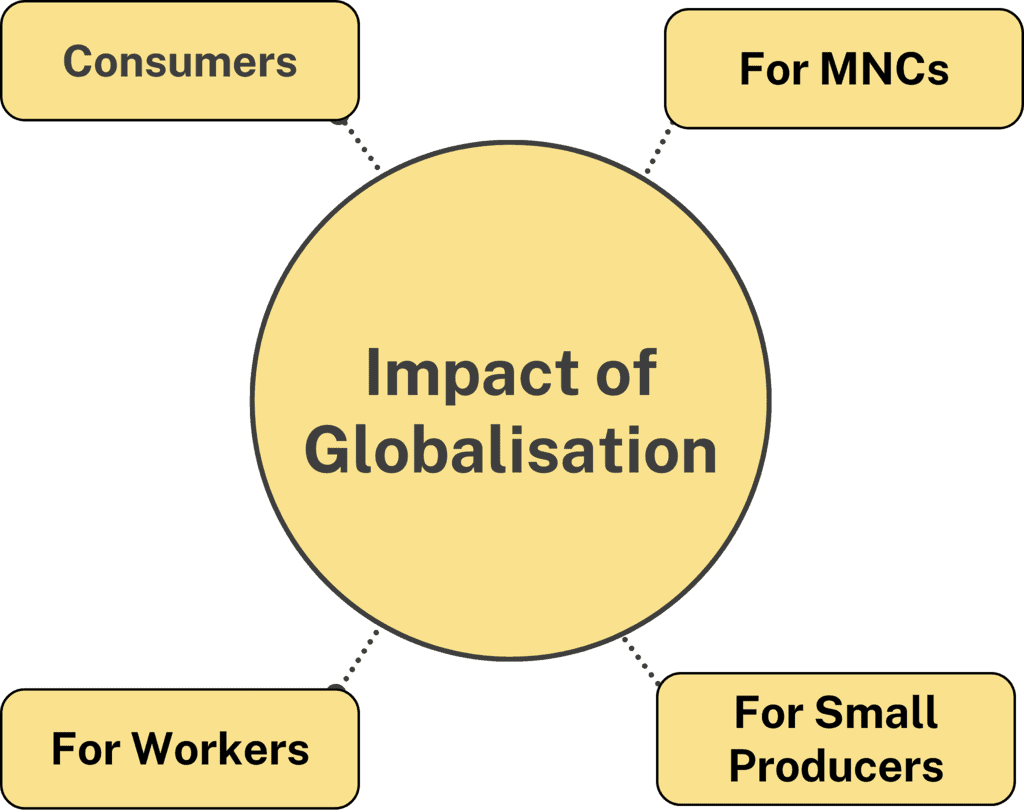 Impact of Globalisation
Impact of Globalisation
1. For Consumers
- Globalisation and increased competition among both local and foreign producers have benefited consumers, especially the wealthy in urban areas.
- These consumers now have a wider selection of products and enjoy better quality and lower prices.
- As a result, their standards of living are much higher than in the past.
- However, the effects of globalisation vary. Urban consumers have access to many products, while rural areas often lack the same opportunities. This difference in lifestyle is shaped by broader economic factors, not just product availability.
- Additionally, MNCs have significantly increased their investments in India over the past 20 years, further shaping the economic landscape influenced by globalisation.
2. For MNCs
 Large MNCs order their products from Indian exporters.
Large MNCs order their products from Indian exporters.
- With the rise of global trade, MNCs have greatly increased their reach and presence in different markets.
- Large MNCs procure their goods from Indian suppliers.
- Investments made by MNCs are referred to as foreign investment, which aims to generate profits from these assets.
- Seeing the potential in urban regions, MNCs are keen to establish factories and offices in sectors like mobile phones, cars, and electronics.
- MNCs have the ability to relocate their operations to other countries to reduce production expenses and maximise profits.
- This relocation can lead to negative impacts on workers, such as job uncertainty and lower pay.
- MNCs contribute funds for further investments and introduce advanced technology for manufacturing, boosting the abilities of local businesses.
3. For Workers
- No Job Security- Due to increasing competition in the market, many employers now prefer to hire workers on flexible terms. This means jobs are less secure, and workers can be let go at any moment.
- The issues regarding work conditions and the struggles faced by workers have become widespread across various industries and services in India. Workers often endure long hours and are required to take on night shifts regularly during busy periods to satisfy employer demands.
- Low Wages- There are limited job opportunities, and exporters are keen on reducing their costs. The number of workers exceeds the available positions, making it easy for employers to find cheap labour. Many workers feel compelled to work overtime just to make ends meet and are often willing to accept lower wages because of financial pressures.
- Large multinational corporations in the garment sector from Europe and America place orders with Indian exporters, which increases competition and puts more pressure on local workers.
- Additionally, workers in the organised sector, like Sushila, no longer receive the protections and benefits they once had.
4. For Small Producers
- Small producers are facing intense competition from well-established firms.
- Many small producers and workers have encountered serious challenges due to globalisation. While some can manage minor losses, numerous units have closed down, leaving many workers unemployed. This competitive strain has forced some small producers to sell their businesses to MNCs. Example: Industries like batteries, capacitors, plastics, toys, tyres, dairy products, and vegetable oil have seen small manufacturers significantly affected by competition.
- Certain large Indian companies, including Tata Motors, Infosys, Ranbaxy, Asian Paints, and Sundram Fasteners, have become multinationals themselves, taking advantage of globalisation by expanding their operations internationally.
- The effects of globalisation vary; skilled workers have found more opportunities, whereas unskilled workers continue to struggle.
- Small and medium industries in India provide the largest employment (11 crores) in the country, following agriculture.
Steps to Attract Foreign Investment
Government Initiatives
- In recent years, both central and state governments in India have implemented measures to draw foreign companies to invest.
- Special Economic Zones (SEZs) are being established, featuring world-class facilities such as:
- Electricity
- Water
- Roads
- Transport
- Storage
- Recreational and educational facilities
- Companies that establish production units in SEZs enjoy a tax exemption for the first five years.
- The government has made labour laws more flexible, allowing companies to hire temporary workers as needed to manage costs.
Impact on Local Businesses
- The creation of SEZs has benefitted local companies by providing them opportunities to supply raw materials.
- This has fostered a mutually beneficial relationship between local businesses and foreign investments.
Opposition and Concerns
- Some groups within India oppose the establishment of SEZs, citing concerns about:
- Displacement of local communities
- Prioritising corporate interests over public welfare
Broader Economic Policy
- The government's liberalisation strategy, backed by international organisations, plays a key role in making India more attractive for foreign investment.

The Struggle for a Fair Globalisation
- Unequal Benefits of Globalisation: Not everyone enjoys the same benefits from globalisation; those with education, skills, and wealth often gain the most, while others miss out.
- Need for Fair Globalisation: To make globalisation more just, it should create chances for everyone and ensure that its advantages are shared more widely.
- Role of Government and Other Entities: Governments can significantly influence fair globalisation, but it’s also important to acknowledge the roles of multinational corporations (MNCs) and employers. Governments can help by:
- Protecting the interests of all citizens, not just the wealthy and powerful.
- Implementing and enforcing labour laws to guarantee workers’ rights.
- Supporting small producers until they can compete effectively.
- Using trade and investment barriers if needed.
- Negotiating for fairer rules at the WTO.
- Working with other developing countries to challenge the dominance of developed nations in the WTO.
- People’s Role: Public campaigns and representation from people’s organisations have affected important trade and investment decisions at the WTO, showing that people can also help make globalisation fairer. The International Labour Organisation has been a key advocate for fair globalisation.
|
66 videos|614 docs|79 tests
|
FAQs on Class 10 Economics Chapter 4 Notes - Globalisation and the Indian Economy
| 1. What are the key factors that have enabled globalisation? |  |
| 2. How do multinational corporations (MNCs) contribute to globalisation? |  |
| 3. What is the role of the World Trade Organisation (WTO) in global trade? |  |
| 4. What has been the impact of globalisation on the Indian economy? |  |
| 5. What does the term "fair globalisation" refer to, and why is it important? |  |






















